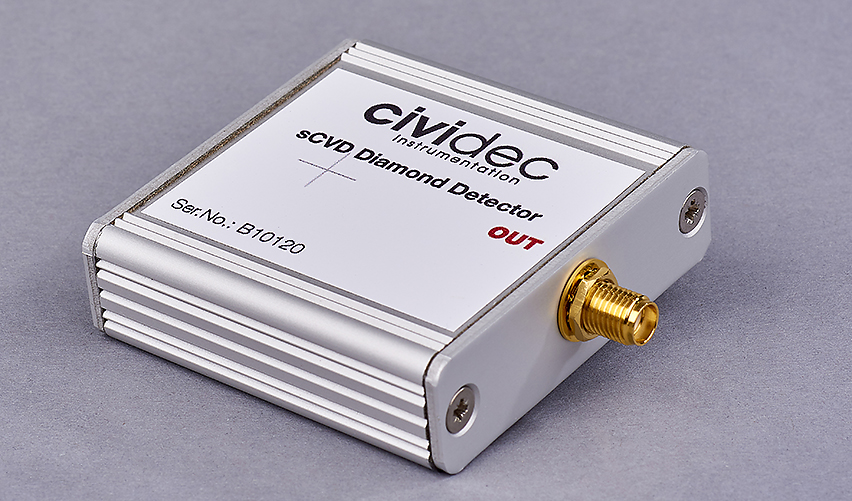B1 sCVD DIAMOND DETECTOR
Universal Diamond Detector
The B1 sCVD Diamond Detector is typically used for single-particle detection. It has a compact design with extra RF shielding and is completely RF tight. The B1 sCVD Diamond Detector can be operated in vacuum as well as at cryogenic temperatures. The detector is read out from the high-voltage side.

The sCVD Diamond Detector is ideal for single-particle detection and identification.
FEATURES
Sensor material:
sCVD diamond
Sensor size:
4.5 mm x 4.5 mm x 500 µm
Electrode size:
4 mm x 4 mm
Charge yield:
3 fC/MIP
Calibration Aperture:
1 mm in diameter
OPTIONS
The B1 sCVD Diamond Detector is used for different measurements in combination with our electronics:
- TCT Measurements: In combination with the C2 – TCT Broadband Amplifier it is optimized for TCT measurements and general detector physics. With this system direct measurements of the detector current is possible and therefore pulse shape analysis.
- Fast & Low-noise Measurements: In combination with the C6 Fast Charge Amplifier fast single particle measurements with an excellent signal-to-noise ratio of 20 for MIP particles and fast particle counting up to 50 MHz is feasible.
- Precision Spectroscopy: In combination with the Cx Spectroscopic Shaping Amplifier the system is dedicated for precision spectroscopy with a counting rate of 1 MHz. The advantage of this system is that the noise level is extremely low.
- Vacuum and Cryogenic Environments: In combination with the Cx-L Spectroscopic Amplifier a 2 m long cable can be used between detector and amplifier, where MIP particles can still be detected with a stable SNR.
DOWNLOAD THE PRODUCT INFORMATION

B1 sCVD Diamond Detector
RELEVANT PUBLICATIONS
Operation of a fast Diamond γ-Ray detector at the HIγS Facility
T. Williams, et al., NIMA, 830, 391-396, 2016
Charge-Carrier Properties in Synthetic Single-Crystal Diamond using the Transient-Current Technique
H. Pernegger, et al., Journal of Applied Physics, 97, 1, 2005
